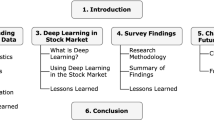Abstract
Enhanced indexation (EI) is the problem of selecting a portfolio that should produce excess return with respect to a given benchmark index. In this work, we propose a linear bi-objective optimization approach to EI that maximizes average excess return and minimizes underperformance over a learning period. Our model can be efficiently solved to optimality by means of standard linear programming techniques. On the theoretical side, we investigate conditions that guarantee or forbid the existence of a portfolio strictly outperforming the index. On the practical side, we support our model with extensive empirical analysis on publicly available real-world financial datasets, including comparison with previous studies, performance and diversification analysis, and verification of some of the proposed theoretical results on real data.








Similar content being viewed by others
References
Adam A, Houkari M, Laurent J (2008) Spectral risk measure and portfolio selection. J Bank Financ 32:1870–1882
Alexander C, Dimitriu A (2005a) Indexing and statistical arbitrage. J Portf Manag 31:50–63
Alexander C, Dimitriu A (2005b) Indexing, cointegration and equity market regimes. Int J Financ Econ 10:213–231
Beasley JE (1990) OR-library: distributing test problems by electronic mail. J Oper Res Soc 41:1069–1072
Beasley JE, Meade N, Chang TJ (2003) An evolutionary heuristic for the index tracking problem. Eur J Oper Res 148:621–643
Benson HP (1998) An outer approximation algorithm for generating all efficient extreme points in the outcome set of a multiple objective linear programming problem. J Glob Optim 13:1–24
Bruni R (2005) Error correction for massive data sets. Optim Method Softw 20:295–314
Bruni R, Cesarone F, Scozzari A, Tardella F (2012) A new stochastic dominance approach to enhanced index tracking problems. Econ Bull 32:3460–3470
Canakgoz NA, Beasley JE (2008) Mixed-integer programming approaches for index tracking and enhanced indexation. Eur J Oper Res 196:384–399
Cesarone F, Scozzari A, Tardella F (2013) A new method for mean-variance portfolio optimization with cardinality constraints. Ann Oper Res 205:213–234
Cesarone F, Scozzari A, Tardella F (2014) Linear vs. quadratic portfolio selection models with hard real-world constraints. Comput Manag Sci (in press). doi:10.1007/s10287-014-0210-1
Dose C, Cincotti S (2005) Clustering of financial time series with application to index and enhanced index tracking portfolio. Physica A 355:145–151
Duffie D (2001) Dynamic asset pricing theory, 3rd edn. Princeton University Press, Princeton NJ. ISBN 069109022
Fábián CI, Mitra G, Roman D, Zverovich V (2011) An enhanced model for portfolio choice with ssd criteria: a constructive approach. Quant Financ 11:1525–1534
Geyer A, Hanke M, Weissensteiner A (2010) No-arbitrage conditions, scenario trees, and multi-asset financial optimization. Eur J Oper Res 206:609–613
Guastaroba G, Speranza MG (2012) Kernel search: an application to the index tracking problem. Eur J Oper Res 217:54–68
Hamel AH, Löhne A, Rudloff B (2014) Benson type algorithms for linear vector optimization and applications. J Glob Optim 59:811–836
Holmstrom K, Goran AO, Edvall MM (2007) Users guide for TOMLAB
Klaassen P (1998) Financial asset-pricing theory and stochastic programming models for asset/liability management: a synthesis. Manag Sci 44:31–48
Konno H, Hatagi T (2005) Index-plus-alpha tracking under concave transaction cost. J Ind Manag Optim 1:87–98
Koshizuka T, Konno H, Yamamoto R (2009) Index-plus-alpha tracking subject to correlation constraint. Int J Optim 1:215–224
Li Q, Sun L, Bao L (2011) Enhanced index tracking based on multi-objective immune algorithm. Expert Syst Appl 38:6101–6106
Löhne A (2011) Vector Optimization with Infimum and Supremum. Springer-Verlag, Berlin. ISBN 978-3-642-18350-8
Markowitz HM (1959) Portfolio selection: efficient diversification of investments. Wiley, New York
Meade N, Beasley JE (2011) Detection of momentum effects using an index out-performance strategy. Quant Financ 11:313–326
Murty KG (1983) Linear programming. Wiley, New York
Prisman EZ (1986) Valuation of risky assets in arbitrage free economies with frictions. J Financ 41:545–557
Rachev S, Biglova A, Ortobelli S, Stoyanov S (2004) Different approaches to risk estimation in portfolio theory. J Portf Manag 31:103–112
Roman D, Darby-Dowman K, Mitra G (2006) Portfolio construction based on stochastic dominance and target return distributions. Math Program 108:541–569
Roman D, Mitra G, Zverovich V (2013) Enhanced indexation based on second-order stochastic dominance. Eur J Oper Res 228:273–281
Ruszczynski A, Vanderbei RJ (2003) Frontiers of stochastically nondominated portfolios. Econometrica 71:1287–1297
Scozzari A, Tardella F, Paterlini S, Krink T (2013) Exact and heuristic approaches for the index tracking problem with UCITS constraints. Ann Oper Res 205:235–250
Sharpe WF (1966) Mutual fund performance. J Bus 39:119–138
Sharpe WF (1994) The sharpe ratio. J Portf Manag 21:49–58
Sortino FA, Satchell S (2001) Managing downside risk in financial markets. Batterworth-Heinemann Finance, Oxford
Thomaidis NS (2012) A soft computing approach to enhanced indexation. In: Natural computing in computational finance, Springer, pp 61–77
Wu LC, Chou SC, Yang CC, Ong CS (2007) Enhanced index investing based on goal programming. J Portf Manag 33:49–56
Author information
Authors and Affiliations
Corresponding author
Additional information
The third author wishes to thank the partial support received from the Spanish Ministry of Science and Technology through grant number MTM2013-46962-C2-1-P.
Rights and permissions
About this article
Cite this article
Bruni, R., Cesarone, F., Scozzari, A. et al. A linear risk-return model for enhanced indexation in portfolio optimization. OR Spectrum 37, 735–759 (2015). https://doi.org/10.1007/s00291-014-0383-6
Published:
Issue Date:
DOI: https://doi.org/10.1007/s00291-014-0383-6




